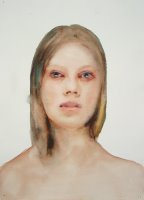Thursday, March 16, 2006
Why We Go to Art Fairs
 As I mentioned the other day, for me fairs aren’t about purchasing. They’re about finding galleries with innovative programs in cities that I don’t regularly visit. This year’s Scope introduced me to three European galleries showing interesting work.
As I mentioned the other day, for me fairs aren’t about purchasing. They’re about finding galleries with innovative programs in cities that I don’t regularly visit. This year’s Scope introduced me to three European galleries showing interesting work.London-based Chinese Contemporary features Chinese work in all media created since 1989. The gallery has the strongest and most clearly enunciated program that I have ever seen. (You think this is hyperbole? Check this out. See. I’m not kidding.)
If I were to allow myself to dream, here’s what I would imagine. Some hugely moneyed person with an interest in art asks me to assemble an important collection. Money and time are not issues. The sole focus is on building a historically significant collection with a well defined scope that represents our age.
If this were my brief, I would start going after contemporary Chinese art. I know next to nothing about contemporary China, and I don’t speak the language. But China today is rapidly undergoing a transition that is more fundamental than any other cultural transformation that I can think of.
Mass migration, rapid urbanization, accumulation of wealth in urban centers, loosening of cultural and political restrictions (but not complete loosening) on artistic creation, conflict between history and contemporaneity. If this all sounds familiar it’s because this same dynamic was at work in America at the turn into the twentieth century. If, as the Whitney so strongly posited with its two 1999 exhibitions, the twentieth century belonged to American art, the twenty-first will belong to Chinese art.
Chinese Contemporary is already there, boots on the ground in Beijing, bringing interesting, charged work to the West. While I saw much of interest at their booth, I was especially taken with work they were showing by Chen Quilin which combines tradition, contemporary capitalism, and urbanization in elaborate staged photographs. (Unfortunately, I can't find any images from this series to post here.)
 Galeria Jorge Alcocela from Madrid was showing four face-mounted, digitally manipulated photographs by Inigo Navarro that I found delightful. Each of the pieces features multiple images of the artist, his grandmother, his girlfriend, or his dog (Tica, above right). Each piece is lighthearted and shows a real tenderness for its subject. I don’t see enough work these days that has been created with such a palpable sense of joy.
Galeria Jorge Alcocela from Madrid was showing four face-mounted, digitally manipulated photographs by Inigo Navarro that I found delightful. Each of the pieces features multiple images of the artist, his grandmother, his girlfriend, or his dog (Tica, above right). Each piece is lighthearted and shows a real tenderness for its subject. I don’t see enough work these days that has been created with such a palpable sense of joy.Bonelli Arte Contemporanea from Mantua was featuring watercolor portraits by Federico Lombardo. At first glance, the pieces reminded me of Kim McCarty’s work—but with slightly older subjects (one example at right). On a more detailed look, though, I began to see that Lombardo’s paintings have much more presence and depth than McCarty’s. They have the same sense of dissipation as her work, but because of the different paper and slightly different technique he uses, the subjects retain more presence than McCarty’s children do. I actually saw a few of McCarty’s pieces the next day at LA Art. Frankly, after seeing Lombardo’s more nuanced work, McCarty’s didn’t impress me as much as it has in the past. An artist who is able to change the way a viewer looks at another artist’s work is doing something powerful.